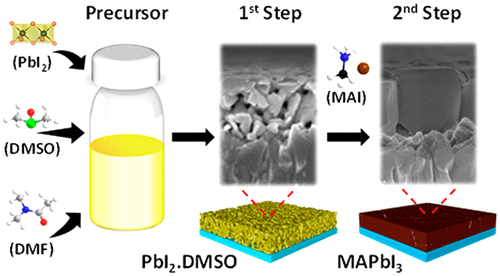当前位置:
X-MOL 学术
›
ACS Appl. Energy Mater.
›
论文详情
Our official English website, www.x-mol.net, welcomes your feedback! (Note: you will need to create a separate account there.)
Facile Deposition of Mesoporous PbI2 through DMF:DMSO Solvent Engineering for Sequentially Deposited Metal Halide Perovskites
ACS Applied Energy Materials ( IF 6.4 ) Pub Date : 2020-03-26 00:00:00 , DOI: 10.1021/acsaem.9b02391 Bin Li 1, 2 , Jiangjian Shi 3 , Jianfeng Lu 4 , Wen Liang Tan 2 , Wenping Yin 1, 2 , Jingsong Sun 1, 2 , Liangcong Jiang 2 , Robert T. Jones 5 , Paul Pigram 5 , Christopher R. McNeill 2 , Yi-Bing Cheng 6 , Jacek J. Jasieniak 1, 2
ACS Applied Energy Materials ( IF 6.4 ) Pub Date : 2020-03-26 00:00:00 , DOI: 10.1021/acsaem.9b02391 Bin Li 1, 2 , Jiangjian Shi 3 , Jianfeng Lu 4 , Wen Liang Tan 2 , Wenping Yin 1, 2 , Jingsong Sun 1, 2 , Liangcong Jiang 2 , Robert T. Jones 5 , Paul Pigram 5 , Christopher R. McNeill 2 , Yi-Bing Cheng 6 , Jacek J. Jasieniak 1, 2
Affiliation

|
Sequential deposition is one of the most promising approaches toward achieving scalable fabrication of metal halide perovskite thin films. However, this fabrication approach conventionally lends itself to the incomplete conversion of the lead halide, which impacts the stability, performance, and reproducibility of functional devices featuring such thin films. In this work, we have overcome this limitation by using a simple solvent and process engineering approach. We show that through the use of an optimized dimethylformamide and dimethyl sulfoxide solvent mixture in the precursor solution, and through the judicious control of this solution, the substrate, and final annealing temperatures, highly uniform and mesoporous PbI2 thin films can be deposited. The porous structure of these films is found to accelerate the interdiffusion of CH3NH3I (MAI) during the second-step process when carried out at room temperature, enabling their complete conversion into CH3NH3PbI3 perovskite. Detailed investigations using scanning electron microscopy, X-ray diffraction, grazing-incidence wide-angle X-ray scattering, thermogravimetric analysis, UV–vis absorption, photoluminescence, and time-of-flight secondary ion mass spectrometry have been used to provide mechanistic insights into the porous PbI2 film formation and the interdiffusion process. Solar cells based on planar fluorine-doped tin oxide (FTO)/TiO2/CH3NH3PbI3/spiro-OMeTAD/Au device architectures yield optimized device efficiencies of 19%, which is among the highest for this device structure and perovskite absorber material. The applicability of this enhanced sequential deposition method to other perovskite systems has been further validated through the fabrication of efficient FAxMA1–xPbIxBr3–x and CsPbIxBr3–x solar cells.
中文翻译:

通过DMF:DMSO溶剂工程方便地沉积顺序沉积金属卤化物钙钛矿的中孔PbI 2
顺序沉积是实现可扩展制造金属卤化物钙钛矿薄膜的最有前途的方法之一。但是,这种制造方法通常会导致卤化铅的不完全转化,这会影响具有这种薄膜的功能器件的稳定性,性能和可重复性。在这项工作中,我们通过使用简单的溶剂和工艺工程方法克服了这一限制。我们表明,通过在前体溶液中使用优化的二甲基甲酰胺和二甲基亚砜溶剂混合物,并通过明智地控制该溶液,底物和最终退火温度,可以获得高度均匀且介孔的PbI 2可以沉积薄膜。发现这些膜的多孔结构在室温下进行的第二步过程中会加速CH 3 NH 3 I(MAI)的相互扩散,使其完全转化为CH 3 NH 3 PbI 3钙钛矿。使用扫描电子显微镜,X射线衍射,掠射入射广角X射线散射,热重分析,紫外可见吸收,光致发光和飞行时间二次离子质谱进行的详细研究已提供了机械方面的见解。进入多孔PbI 2膜的形成和相互扩散过程。基于平面掺氟氧化锡(FTO)/ TiO 2的太阳能电池/ CH 3 NH 3碘化铅3 /螺环-OMeTAD / Au的器件结构收益率吸收材料优化的19%,这是最高的该器件结构中器件效率和钙钛矿。通过制造高效的FA x MA 1– x PbI x Br 3– x和CsPbI x Br 3– x太阳能电池,进一步验证了这种增强的顺序沉积方法在其他钙钛矿体系中的适用性。
更新日期:2020-03-26
中文翻译:

通过DMF:DMSO溶剂工程方便地沉积顺序沉积金属卤化物钙钛矿的中孔PbI 2
顺序沉积是实现可扩展制造金属卤化物钙钛矿薄膜的最有前途的方法之一。但是,这种制造方法通常会导致卤化铅的不完全转化,这会影响具有这种薄膜的功能器件的稳定性,性能和可重复性。在这项工作中,我们通过使用简单的溶剂和工艺工程方法克服了这一限制。我们表明,通过在前体溶液中使用优化的二甲基甲酰胺和二甲基亚砜溶剂混合物,并通过明智地控制该溶液,底物和最终退火温度,可以获得高度均匀且介孔的PbI 2可以沉积薄膜。发现这些膜的多孔结构在室温下进行的第二步过程中会加速CH 3 NH 3 I(MAI)的相互扩散,使其完全转化为CH 3 NH 3 PbI 3钙钛矿。使用扫描电子显微镜,X射线衍射,掠射入射广角X射线散射,热重分析,紫外可见吸收,光致发光和飞行时间二次离子质谱进行的详细研究已提供了机械方面的见解。进入多孔PbI 2膜的形成和相互扩散过程。基于平面掺氟氧化锡(FTO)/ TiO 2的太阳能电池/ CH 3 NH 3碘化铅3 /螺环-OMeTAD / Au的器件结构收益率吸收材料优化的19%,这是最高的该器件结构中器件效率和钙钛矿。通过制造高效的FA x MA 1– x PbI x Br 3– x和CsPbI x Br 3– x太阳能电池,进一步验证了这种增强的顺序沉积方法在其他钙钛矿体系中的适用性。


























 京公网安备 11010802027423号
京公网安备 11010802027423号